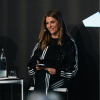
Virgin Media O2 launches summer online safety campaign
Virgin Media O2 and Internet Matters spotlight the importance of having conversations about online safety and starting them early

With the Women’s World Cup around the corner, we asked industry leaders to have their say on this historic tournament.

As the Women’s World World Cup prepares for kick off on July 20th questions remain if brands are on the sidelines. Following the Lionesses' success in the Euros a new host of fans are hotly anticipating the tournament. It is expected that 1.5 million tickets will be sold.
The emergence of new talent, sold-out matches and pay increases making strides to equalise with men all spark innovation across the sport. The sport is paving a new identity and building a unique culture of inclusivity through its fanbase. But questions remain as to the role that brands are taking in building that momentum.
Speaking at Ad Week and echoing the words of trailblazing footballer Alex Scott, Gabby Logan warned that ‘brands not investing in women’s sport may have missed the boat’. The opportunity to maximise on a plethora of dedicated, loyal and engaged fans is an exciting prospect for brands, but to do so disingenuously no longer cuts it.
With this in mind, we asked industry leaders if brands are doing enough to capitalise on the marketing opportunity of the Women’s World Cup?

This Women’s World Cup will be a big moment for adidas. All World Cups are special, but this one really brings us to a tipping point for the women’s game. One that’s been a long time coming.
It is a unique opportunity, and that’s something to be celebrated – investment means visibility and growth. We’ve been an official partner to FIFA and the tournament since 1995, but it’s clear that Women’s football has made huge progress in that time and specifically in the four years since the last tournament. In part this is due to more support from sponsors but what’s important is that those sponsors show up consistently long term as true partners who are invested in growing the game.
This month, to coincide with the tournament, we launch our new football campaign featuring next generation icons Mary Fowler, Alessia Russo and Lena Obedorf (among some other adidas legends you might recognise!). We also have an industry-leading mix of products designed to help our athletes be at their best throughout the tournament as well as designs to excite fans around the world and bring them into the game. But for us, it’s so much more than that. It’s an opportunity to shape the future of the sport. To inspire the next generation of girls to explore their potential, to stay in sport and see the possibilities it can create – on a global scale.

There's been seismic progress in the women's game, which has been helped along by brands engaging with the sport. But for the Women's World Cup it's finally time our industry stopped using women's football as a convenient strand of 'purpose' marketing.
Players, clubs and supporters alike have been campaigning for women's football to be taken more seriously. Given the sport's growth, campaigns like EE's 'Not Her Problem' campaign - may feel out of touch to fans who want to focus on the sport, not the adversity.
For those looking to play a more authentic and effective role, there are exciting creative opportunities for brands to place themselves at the heart of an emerging supporter culture. Unlike men's football supporters, most Women's World Cup supporters are new supporters and they're writing their own rules of what ‘fandom’ means and what 'fans' looks like – creating a healthier and more inclusive football culture that in its own way is teaching the men's game new tricks.
To sum up; when brands put ‘purpose’ over ‘performance’, the women’s game becomes secondary to sexism. Now there’s a huge opportunity for brands to win over fans by focussing on the unique culture of the sport itself, not the adversity facing it.

Currently, the marketing potential of the Women's World Cup isn’t being fulfilled by brands, although there are areas where they can make a difference.
Two key challenges are the time difference, along with a continued lack of support and decisiveness from European broadcasters, that may discourage casual viewers from tuning in. These factors may also cause brands to think twice about their investment and marketing around the tournament.
However, there are also opportunities that should not be overlooked. There is an enthusiastic women's football community that is eager to see investment in the sport they love. Moreover, the audience for women's football is growing substantially year on year with more families, women and younger girls watching matches IRL and on TV - opening up a whole new sector for brands with a similar target audience to invest. By doing so, these brands can help create the next generation of female footballers by shining a light on current players, on & off the pitch, and enabling younger fans to dream of one day playing at a World Cup.
It's clear that brands can make a difference by investing in the Women's World Cup and supporting women's football. They can help promote the sport, increase viewership, and encourage more young girls to take an interest in playing football. This could create a long-lasting impact on the sport and women's sports more generally.

Brands have a big part to play in the world of women’s football, extending beyond the mere month-long focus of the Women’s World Cup. While short-term sponsorship deals can yield immediate returns, the true value lies in embracing long-term strategies that support and elevate women's football.
Research indicates that fans of women's sport are 25% more likely to purchase sponsor products, compared to followers of men's sport. Additionally, brand recall among women's sport fans is twice as likely as among those who follow men's sport. These findings highlight the significant commercial potential for brands to tap into, provided they are willing to make sustained and meaningful contributions to the women's football industry. After all, 50% of fan’s of women’s sport ‘strongly agree’ that sponsors should ‘look to make the world a better place.’
Brands must be willing to take risks, challenge norms and engage with fans in meaningful ways. This will require not only financial support for Women’s football, but also actively working to create equal opportunities, foster talent, dispel stereotypes and amplify the voices of female athletes. By doing so, they can connect with a new generation of fans and create enduring loyalty that extends far beyond the World Cup.

The Women’s World Cup represents a large-scale opportunity for brands to get on board and invest their support across women’s sport.. But despite sponsorship increasing by 20% year-on-year, fan numbers reaching nearly 38 million, and women’s sport in the UK expected to generate over £1 billion (US$1.2 billion) in revenue a year by 2030, brands still aren’t tapping into it in a meaningful, authentic way.
Rather than just jumping on the latest trend or event, in an attempt to maximise ROI, brands should be looking to the long term (not the short term) and treat women’s sport as if it were a start-up - it requires commitment and time. Barclays, who have leveraged their big profile and budget to inspire and engage younger audiences into grassroots football through their sponsorship of the Women’s Super League, is proof that long term activations can drive real change to the sport and benefit the brand.
When it comes to women’s sport in general, female health has been consistently underfunded and overlooked. While few and far between, some brands are going beyond the realm of tactical marketing and creating more interesting and supportive activations in this space that lead to real change. Vodafone has just launched first-of-its-kind menstrual tracking technology for the Wales Women’s Rugby team – developed by Fuse. The new menstrual tracking programme is part of Vodafone’s PLAYER.Connect platform, and aggregates data from athletes’ wearable devices in real-time to analyse how the menstrual cycle impacts performance, wellbeing and recovery.
Brands can, and should, capitalise on the untapped opportunities of the Women’s World Cup but need to see it as the first step to long-term commitment.

There is still a significant gap between the investment in men’s and women’s football - especially with ad campaigns and sponsorship deals. And although it’s likely that the Women’s World Cup will attract a new wave of brands looking to align with the increased engagement with women’s football, most campaigns and sponsorship deals will come from brands already entrenched in men’s football (think Adidas and Visa who are the men’s FIFA sponsors).
With almost two-thirds of football fans more interested in watching women’s football following the Lionesses success, there is a wealth of opportunity for new brands who have previously not been able to break into the female football scene, to create authentic connections with this audience by offering holistic benefits to women and girls at all levels.
But to avoid ostracising this new audience, brands mustn’t think of women’s football as just a ‘new trend’. Fandom within women’s football is here to stay, and to truly capitalise on the marketing opportunity of the women’s world cup consumer insights must be at the heart of any brand campaign to ensure the brand is communicating with this audience authentically.
This summer, we hope to see World Cup campaigns from brands that support women’s football at all levels - from the professional game down to grass roots - all while demonstrating an understanding of the community they are getting involved in. For example, Moju drinks recently offered to sponsor my beginners football team (@shes.the.man.united), providing a kit for everyone in the team.

I think it’s a little hard to say definitively right now, as we’ve yet to see the big campaigns we’re expecting from official sponsors that will likely only launch nearer the time. Putting aside for a moment the fact that FIFA itself was definitely capitalising on the opportunity when it accepted - and then had to turn down - Visit Saudi as an official partner of the games (what were they thinking? Oh, wait: £££), what worries me most is the fact that as of today, it looks like the matches will be seen by precisely no-one in the UK. Rights bids from UK broadcasters (along with other European nations) are just too low for FIFA to countenance (apparently up to 100 x less than what was bid by broadcasters for the Men's World Cup). Yes, there are time-zone challenges for live matches, but you have to assume broadcasters are also worrying about their ability to sell advertising space during the matches. (This is after all uncharted territory, being the first time the rights are being sold separately from the Men's World Cup.) Should they be worried? Are brands ready to pay (relatively) big bucks to be associated in real-time with the Women’s World Cup? You’ve got to hope they are: surely the opportunity to tap into the massive zeitgeist around women’s football - at a time when you get to do so at a relatively low-cost compared to the men’s game - is a no brainer.

Timing plays a crucial role in successful marketing campaigns and it’s still too early to expect significant marketing activity surrounding the Women's World Cup. With the tournament kicking off in late July, we will likely start seeing activity in early June, once domestic competitions in men’s and women’s games have finished. The only countries where this wouldn’t apply is the US, where the domestic season is played during the summer and Australia, given they’re hosting the tournament. The activity in Australia & NZ is likely to be the most intense.
The challenge this tournament presents for most brands is the difficulty in following it due to time zones. In Europe, many of the games will take place during the night or early morning, assuming FIFA eventually agrees broadcasting deals in all the major markets. Most brands prioritise viewership and the ability to engage with consumers around major tentpole moments like the Women’s World Cup. If, however, there are concerns about how people will engage with the tournament then it will certainly impact marketing plans.
Host nations will see the most activity, followed by the US and UK. Brands will certainly get behind the tournament but I suspect not at the scale we would hope for a global event of such stature.

Sports brands have been at the forefront of growth in brand sponsorship of the women’s game in terms of player and team endorsements, targeted creative content and female-specific products. However, it is crucial for other categories to recognise the immense potential that women's sports offer for speaking to a passionate and engaged audience.
The Women’s Sport Trust found that 20.6 million people tuned into three minutes or more of women’s sport in the first four months of 2023, surpassing the 18.9 million viewers during the same period in 2022. The data also shows that 34% of viewers hadn’t watched the sport before, indicating a widening fan base and an opportunity for brands to engage with new audiences.
This extends beyond major events such as the Women's World Cup, and requires sustained investment and tailored messaging. Brands should invest in women's sports at the grassroots level. By doing so, they can contribute to growing interest and expanding future fan bases. The resulting increased profile will lead to more visibility, and therefore larger audiences, so will ultimately benefit brands as well as the sport.

The upcoming Women’s World Cup is a golden marketing opportunity; it’s a chance to engage with emerging and hard-to-reach audiences, create meaningful partnerships that put performative feminism to bed and support the sport and the amazing women that play in it. So why aren’t more brands exploring innovative ways to support it and capitalising on a moment that has a huge engagement potential?
It’s great to see some notable brands, such as Dove, Adidas and Coca-Cola setting a benchmark for others to follow, but we want to see more looking to these big-moment events as a way to broaden their horizons. It’s an open goal for brands in sectors that have been seen as traditionally male-centric, such as tech and automotive, to be shifting in a new, positive and progressive direction.
Fans across the board are craving more personal interactions with brands they interact with, so marketing strategies should reflect this demand and consider a long-term strategy, rather than fleeting partnerships to capitalise on a moment in time. Audiences are also increasingly participating in cross-screen experiences, using their mobiles during and after matches. Therefore, brands should consider collaborating more with content creators by building them into their wider digital strategy. Engaging with consumers in this way will harness trust between influencers and their audiences across various channels, driving sales and exposure to a point of inspiration.
With social media bolstering the profile of sport over recent years, particularly women’s sports, and 43% of Gen-Z fans using social media platforms whilst watching it, tapping into content creators can be extremely effective to provide brands with an access route to consumers that feels authentic.
Looks like you need to create a Creativebrief account to perform this action.
Create account Sign inLooks like you need to create a Creativebrief account to perform this action.
Create account Sign in